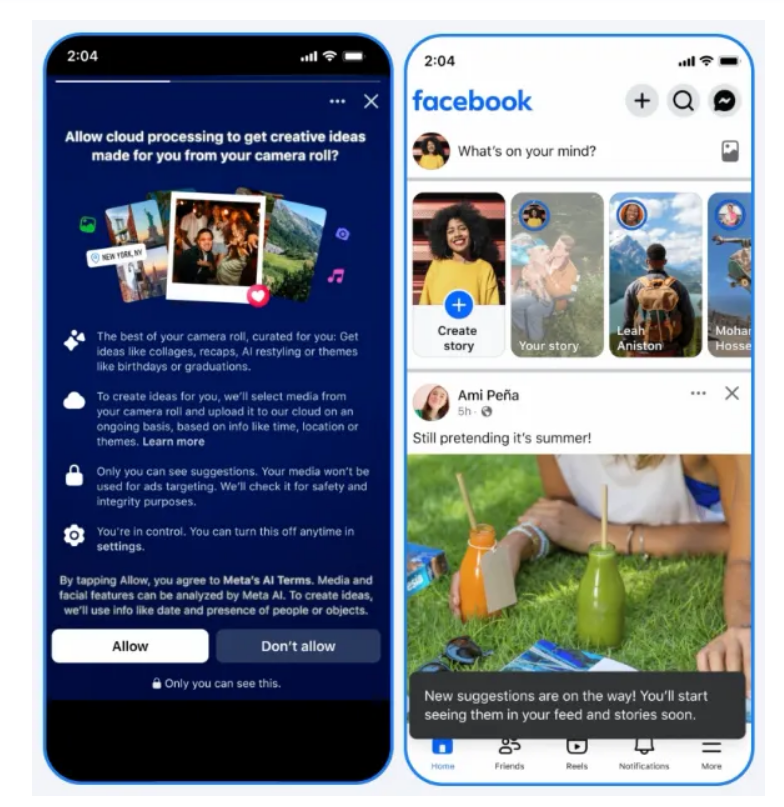Facebook is rolling out a new AI-powered feature that scans users’ device camera rolls — even images and videos not yet uploaded — to surface “hidden gems” for posting. With this move, Facebook is doubling down on personalised content prompts and shifting from passive feed behaviour to proactive suggestions. For creators and brands, this update signals both opportunity and caution.
How the Feature Works
Under the new opt-in system, users in the U.S. and Canada (with wider rollout to follow) will find a toggle in settings labelled something like “Camera roll sharing suggestions”. Once enabled, Facebook’s AI begins analysing recent images and videos on the device to identify:

- Photos and moments that might be worth sharing (e.g., trips, events, group shots)
- Collections of images that could be turned into collages or stories
- Visual opportunities that the user may have overlooked among everyday snaps, screenshots, and mundane uploads
The intent is to reduce friction: many of us capture thousands of moments but post only a few. Facebook’s prompt mechanism says: “Let us help you find something worth sharing.”
But to make this happen, the app must access and upload some content from the camera roll into Meta’s cloud for processing. While the company insists it’s entirely opt-in and that media is only used for suggestions (not ad targeting) unless edited/shared, privacy watchers remain uneasy about how wide the access is and what it might enable next.
Why This Update Matters for Creators & Brands
1. A Shift Toward Ever-Greener Content
This tool emphasises that Facebook wants constant sharing — not just when creators publish new videos. The sooner you build a strategy around “moments to share” (not just big productions), the more you’ll align with Facebook’s algorithmic push.
2. Elevated Expectations for Visual Quality
Because the AI will prompt users with images it flags, creators need to up their visual game. If user photos get elevated to suggestions, brand content must match or exceed that quality to avoid being overshadowed in the feed.
3. Opportunity for Smaller Creators
This suggestion engine expands the “entry point” for posting. Creators who consistently generate authentic, visually engaging snapshots may gain visibility when users accept prompts and share. For those managing multiple profiles or running experiments in parallel, using the Buy Bulk Facebook Accounts Guide becomes relevant to test creative hooks and publishing flows across segments.
4. Privacy is Now a Content Factor
In a world where users are more cautious about their data, features that prompt sharing from private device storage can trigger backlash. Brands must account for this. When your content asks for or leverages user device access, you’re venturing into trust territory.
How to Adapt Your Strategy
Re-imagining Moment-Based Content
Instead of only focusing on high-budget posts, schedule regular “everyday moment” content: behind-the-scenes, casual life snapshots, user-generated imagery. Use story formats, albums, or carousels that feel natural and prompt engagement.
Create Visual Templates for Re-use
Build a gallery of templates for collages, recap visuals or mini stories — these match the kind of output Facebook’s AI is suggesting. Then test variations across accounts using a multi-account approach. If you’re scaling across different niches, consider utilising Buy Bulk Discord Accounts (for cross-platform community funnels) alongside your Facebook strategy to drive broader engagement.
Align Publishing Timing with Suggestions
When the camera-roll AI suggests content, it may increase spontaneous posting. Be ready by scheduling some “quick post” windows or enabling mobile-first workflows so that your brand can act fast when a moment surfaces.
Guard Against Privacy Backlash
Transparency matters. If you run communities or collect user-generated visuals, make sure you clearly state permissions, respect opt-out access, and avoid tone that feels intrusive. A small privacy misstep could drastically impact your engagement.
Experiment Aggressively Across Accounts
Because this new feature is still rolling out, outcomes will vary. Using segmented profiles (e.g., one for spontaneous moments, one for high-production content) helps you test what works best. Use your multi-account infrastructure (such as ones acquired through Buy Bulk Facebook Accounts Guide workflow) to protect your main brand while you test aggressive creative approaches.
Risks & Considerations
- User Resistance: Some may balk at a feature suggesting posting private content. Negative sentiment could hamper sharing rather than boost it.
- Data Access Concerns: Even if it’s opt-in, the fact that images on your device are accessed might raise friction. Low-trust audiences may disengage.
- Over-reliance on Prompts: If your content hinges only on user-generated suggestions and you neglect your own creativity, you may miss strategic brand opportunities.
- Volume vs. Value: More posting isn’t always better. Without quality, the increase in output could dilute brand perception.
The Bigger Picture: Facebook’s Retention Fight
Facebook is under pressure — younger users spend more time on TikTok, Instagram Reels and emergent platforms. By leveraging device-stored content to prompt sharing, Facebook unlocks a new internal pipeline: users don’t need to think of posting—they are nudged to post. That helps retention, frequency, and time spent.
For creators, the takeaway is clear: you must be visible, mobile-optimised, responsive and ready to pivot. For brands, the future of social content may be less about big launches and more about fluid moments. And managing this at scale means multiple profiles, agile workflows and a readiness to divide your strategy across platforms such as Discord for real-time community growth.
